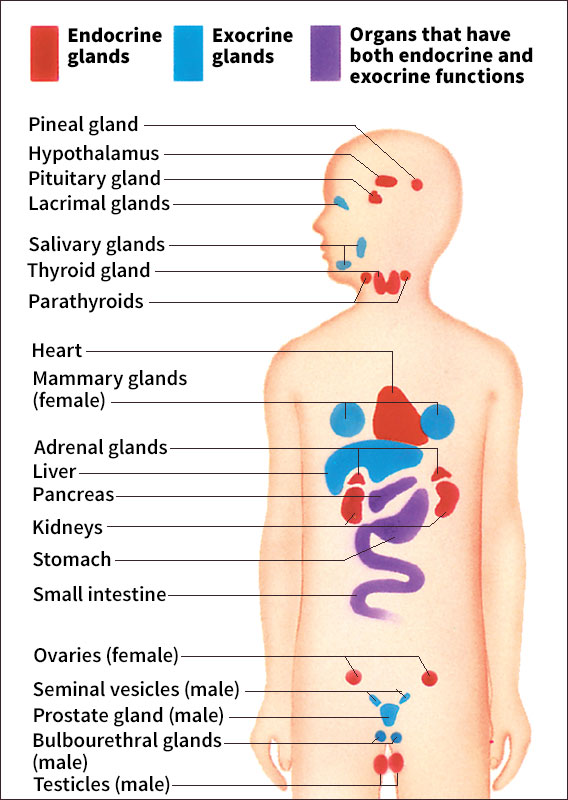Gland is a tissue or organ that produces and releases a chemical substance. There are glands throughout the bodies of humans and most other animals. The substances released by glands perform a wide range of functions. For example, some of these secretions help keep the skin moist. Others promote digestion. Still others regulate the growth and development of the body.
Humans have two chief kinds of glands—endocrine glands and exocrine glands. These glands differ in their method of secretion. Endocrine glands release secretions directly into the bloodstream. Exocrine glands discharge secretions into small ducts (tubes). The ducts lead to the outer surface of the skin and eyes or to the interior surfaces of such organs as the stomach and small intestine.

Endocrine glands,
also called ductless glands, help the nervous system regulate certain body activities and enable parts of the body to communicate with one another. These glands produce and secrete chemicals called hormones, which travel through the blood. After a hormone arrives at its target—that is, the organ or tissue it affects—it causes certain actions to occur.
Hormones regulate such body processes as growth and development and reproduction. They also coordinate the body’s responses to stress and help keep the chemical composition of the blood within normal range. In addition, hormones regulate the process by which the body changes food into energy and living tissue.
Most endocrine glands are organs and produce one or more hormones. Some of these glands consist of two or more parts, each of which secretes different hormones. For example, each of the two adrenal glands, atop each kidney, has two parts—the cortex (outer layer) and the medulla (inner layer). The cortex produces the hormones cortisol and aldosterone. The medulla secretes the hormones epinephrine and norepinephrine. Many organs not usually considered endocrine organs contain isolated clusters of cells that secrete hormones. Examples include the kidneys, pancreas, and stomach.
The pituitary gland is one of the most important endocrine glands. It lies at the base of the brain and consists of two parts, the anterior lobe and the posterior lobe. The anterior lobe releases hormones that regulate the secretions of many other endocrine glands. For this reason, the pituitary is sometimes called the “master” gland. The anterior lobe of the pituitary is controlled by a part of the brain known as the hypothalamus. The hypothalamus secretes releasing hormones, which cause the anterior lobe to discharge its hormones. The hypothalamus consists of nervous tissue. It forms the main link between the body’s endocrine and nervous systems.
Some endocrine glands are not controlled by the pituitary or the nervous system. These glands, such as those that help maintain the normal chemical composition of the blood, respond to changes in the amounts of such chemicals. For example, the parathyroid glands, in the neck, secrete parathyroid hormone when the amount of calcium in the blood drops below the normal level. Parathyroid hormone causes a rise in the calcium level of the blood.
Diseases of the endocrine glands may cause them to secrete too much or too little of a hormone. Most cases of excess secretion result from tumors. Insufficient secretion occurs if a gland has been partly destroyed. This destruction may be caused by cancer, decreased blood supply to the gland, or, in rare cases, infection. In many instances, however, the partial destruction of a gland results when the body’s own disease-fighting cells mistakenly attack its healthy tissue.
Exocrine glands
do not empty their secretions directly into the bloodstream. Instead, ducts carry their products to the surface of the skin or to the lining of other organs. Exocrine secretions perform many functions. The sweat glands, for example, secrete fluids that help cool the skin through the evaporation of water. The sebaceous glands supply oil that lubricates the skin. The lacrimal glands produce tears, which moisten the eyes. Other exocrine glands secrete substances that moisten and lubricate internal organ surfaces. Exocrine glands in the mouth, the stomach, and intestine help digest food.
Certain exocrine glands secrete scents known as pheromones. Pheromones play a role in communication among individuals in many animal species. Their role in human behavior is more limited. See Pheromone.
Some exocrine glands consist of single cells. For example, millions of goblet cells act to moisten the lining of the respiratory and digestive systems. Other exocrine glands are made up of a glandular portion and a duct portion. The glandular portion produces secretions. The secretions then exit the glands through the ducts.
Most exocrine glands release their secretions in response to stimulation of local nerve endings. But the secretions of some exocrine glands are controlled by hormones. For example, gastrin, a hormone secreted by the stomach, stimulates certain exocrine glands to release digestive juices. Exocrine glands may be affected by various diseases that disrupt their secretions.
Glandlike structures.
The thymus, an organ in the chest, is often called a gland. This organ helps protect the body against disease. The thymus releases hormones called thymosins that stimulate the development of the immune system. However, thymosins are not strictly thymus hormones. They are produced in many different tissues besides the thymus. Some groups of lymph nodes, particularly those of the neck and armpit, are also called glands. But these structures do not produce secretions. Like the thymus, lymph nodes form part of the body’s system of defense against disease.
